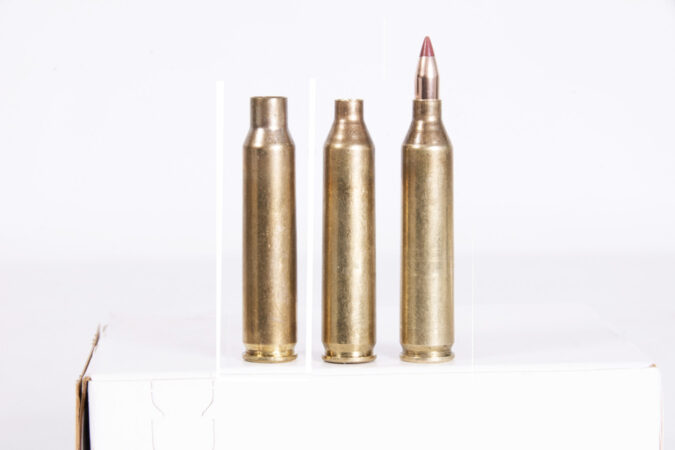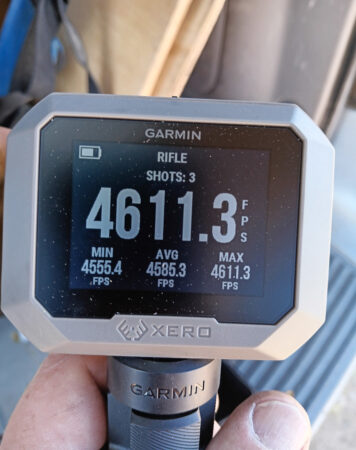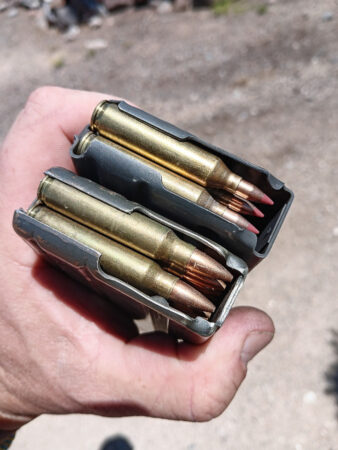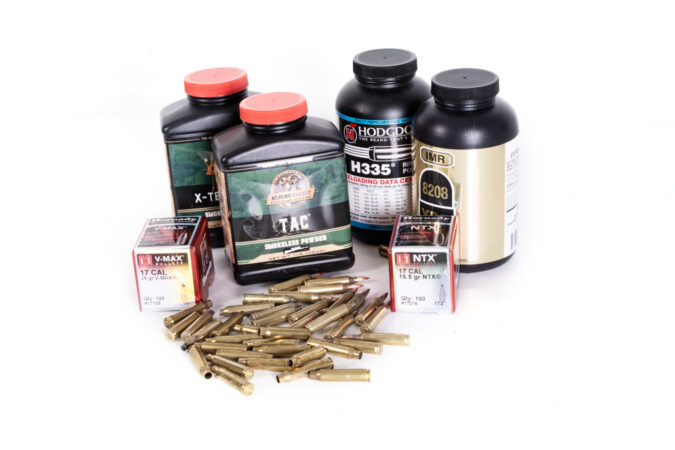KAK Industry 17-556 AR: America is All About Speed. Hot, Nasty, Badass Speed.
Photos by Kenda Lenseigne
Niche rounds like 6mm ARC are one thing, but why on earth would anyone want yet another AR-15 cartridge, let alone one that has no available factory ammo? The answer is, as alluded to above, velocity. This isn’t a general-purpose plinking/training/self-defense round — but for turning small creatures into pink mist, it’s hard to think of one that could do a better job and still fit into a STANAG magazine.
So, just how fast are we talking about? Think 4,600 feet per second out of an 18-inch barrel, using Hornady’s 15.5-grain, 17-caliber bullet. The more practical 25-grain V Max steps out at a sedate 3,900 fps depending on the load, but will still completely fragment in about 4 inches of gel, making both a safer option if you live around neighbors — the chances of a ricochet are greatly reduced.
At extreme speed, bullets turn to dust as soon as they hit any kind of resistance. If you’re hunting coyotes or bobcats, this kind of performance is fur-friendly, as there’s a tiny pinprick entry wound and no exit, but everything within a couple of inches of the bullet’s path is turned to crimson goo.

There have been other 17-caliber cartridges capable of being chambered in America’s rifle — .17 Remington and .17 Fireball are a couple of examples — but this one is the easiest to make.
Introduced way back in 1971, the first successful 17-caliber centerfire, the .17 Rem has always had a mixed reputation for screaming velocity, coupled with temperamental accuracy caused by rapidly deposited copper fouling in barrels that weren’t always finished well enough.
It’s currently expensive to feed, with factory cases running at over a buck a piece, and making 5.56 brass into .17 Rem is a complicated, multi-stage process that often results in crushed cases and shattered dreams.
17-556, on the other hand, is easy to live with. Take once-fired military brass, run it through the sizing die, and — boom — it’s ready to prime and load. Once formed, the case looks a little odd with its short neck, but we didn’t encounter any accuracy issues with the recipes we cooked up, and in terms of load development, it’s one of the easier wildcats we’ve worked with.

Right now, bullet choices are a bit limited as Berger got out of the 17-cal game a couple of years ago, but the Hornady options cover most bases. And if you look hard, you can find offerings from Nosler and Hammer. One aspect of the 17-556 is notable — its flexibility when it comes to powder, particularly useful in the current market in which we find ourselves.
We started off with the usual suspects like H332 and H335, but one of our most accurate loads came from a powder usually considered much too slow to use in the .223 case, namely Winchester Staball 6.5 designed, as its name suggests, for use in the Creedmoor.

King of the velocity hill was Ramshot X-terminator, yielding an insane 4,585 fps average with the tiny Hornady NTX bullet from 26.1 grains of powder. Note that this is a maximum load that was safe in our gun and showed no obvious pressure signs, but if you don’t follow safe reloading practices and work up to it, then prepare to suffer the consequences. Stupid should hurt.
With non-existent recoil and laser beam trajectory inside 250 yards, it’s easy to get carried away on the trigger and hose down a prairie dog town — bringing us to another one of the 17 cal’s key characteristics. Shoving this much superheated gas down a tiny bore leads to accelerated throat erosion and quite possibly a barrel life of less than 1,000 rounds.
With any other .17 centerfire, this would probably mean an expensive trip to the gunsmith and a long wait while a new barrel was chambered and installed. But at 200 bucks, the KAK 17-556 barrel is pretty much a disposable item, and if you have an AR-15 action block and barrel nut wrench (and as a red-blooded American, who doesn’t?), then it’s a 15-minute job to swap it out.

We used a complete KAK upper, including their rail and enhanced bolt carrier group, for load development and testing, though if you already have a bunch of spares in the parts bin, you could simply use what you’ve got.

We do, however, recommend the use of an adjustable gas block and H3 buffer, as there’s a fairly wide range of charge weights depending on powder and projectile choice. Throw a suppressor into the mix, and there’s a good chance you’ll find ejector swipes and cases being kicked out to the 2 o’clock position.
If you’re looking for a useful tool for pest eradication, or you simply want to be the fastest kid on the block, then the 17-556 barrel from KAK Industry is worth your time to investigate. It’ll never replace .223, but for certain specialized tasks, it’s a great club to add to the golf bag.

NEXT STEP: Download Your Free Target Pack from RECOIL
For years, RECOIL magazine has treated its readers to a full-size (sometimes full color!) shooting target tucked into each big issue. Now we’ve compiled over 50 of our most popular targets into this one digital PDF download. From handgun drills to AR-15 practice, these 50+ targets have you covered. Print off as many as you like (ammo not included).
Get your pack of 50 Print-at-Home targets when you subscribe to the RECOIL email newsletter. We’ll send you weekly updates on guns, gear, industry news, and special offers from leading manufacturers – your guide to the firearms lifestyle.
You want this. Trust Us.

Read the full article here


